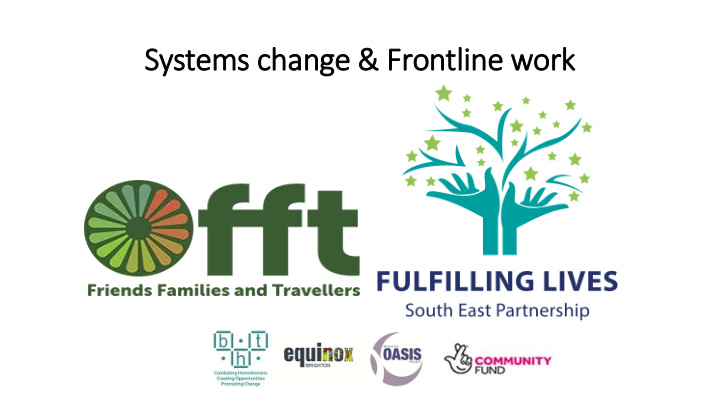



Systems change & Frontline work
Systems change & Frontline work We’ve always done it this way! Same old results! Same old thinking
How to be a systems thinker… introduction!
If you take away one thing from this presentation today, consider this…… • Up to this point there has always been someone/something to blame for every problem: The other teams, their bosses, not enough time…..”When the “they’s go away and the We’s show up, peoples awareness and capabilities change”
Today we will cover… 1. A brief history and context of systems change. 2. Journey mapping. 3. Rich pictures and cause & effect. 4. Systems change process & principles. 5. Personal qualities needed. 6. Unintended consequences of systems change.
A brief history of systems change • 1854 – Dr John Snow and Reverend Henry Whitehead use local knowledge, scientific research and map making to defeat cholera (Source: Ghost Map, Penguin Books). • Epidemiology, sociology etc • 2014: Fulfilling Lives is commissioned by the National Lottery Community Fund. • 2015: Lankelly Chase put together their ‘Hard Edges: Mapping Severe and Multiple Disadvantage in England’ report drawing upon previously separate datasets from homelessness, offending and substance misuse treatment systems.
John Snow’s map of the cholera dead after London’s 1854 epidemic is often heralded as one of the earliest examples of graphical data analysis.
Ghost map short video • https://www.youtube.com/watch?v=dXKPYT408Rw
Qualitative & Quantitative evidence together • Dr Snow and the Rev Henry Whitehead demonstrated the power of using statistics and data and the stories of individuals together to tackle the cholera outbreak. • This was the beginning of epidemiology. • How can we use similar methods to evidence the needs for systems change in supporting people with multiple and complex needs? • Statistics + Human stories = power to leverage change
The Ghost Map “The history of knowledge conventionally focuses on breakthrough ideas and conceptual leaps. But the blind spots on the map, the dark continents of error and prejudice, carry their own mystery as well. How could so many intelligent people be so grievously wrong for such an extended period of time? How could they ignore so much overwhelming evidence that contradicted their most basic theories? These questions, too, deserve their own discipline—the sociology of error.” ― Steven Johnson, The Ghost Map: The Story of London's Most Terrifying Epidemic--and How It Changed Science, Cities, and the Modern World
Journey mapping
Example case – Aaron! • Aaron is a 50 year old male with a long history of rough sleeping, alcohol use and has had various M/H diagnoses. • Efforts to engage Aaron in mental health services have not worked because of intoxication and non-compliance. • Aaron has a goal to go to rehab, become abstinent and lead a happy life. • Instead of continuing to approach mental health services, FL decided to use safeguarding processes to initiate a referral to out of area rehab. • Aaron is now doing well.
Mental health services I am going to use Access Point! Mental health services Mental health services
Other tools to map the system… Part of a rich picture of a telephone helpline situation Rich pictures:
Multiple cause & effect Client drinks more Mental health Client rough sleeps declines Behaviour Client is evicted becomes a problem
Multiple cause & effect 2
Vulnerable women & EA placements
Cause & Effect exercise – Ask about Aaron! Ask who, when, where, what, why and how questions… From point A to point B
Seeing the system, how do we change client outcomes and the system? 1. Firstly, how do we see the system? What is our perspective? 2. Systems mapping. 3. Cause & effect. 4. Finding the flex. Where the system can change. 5. Systems design – experimenting with change. 6. What have we learned? And then what?
3 stages of systems change
Skills/qualities needed to be a systems changer?
Skills/qualities needed to be a systems changer? • Observation – an ability to see things through different lenses, from different perspectives. • Questioning your surroundings – use who, what, when, where, how and why questions. • An ability to survive precariousness and change. • Boldness – an ability to ask questions, collaborate with new people, make changes, be challenged and to learn. • Being bold in the face of change.
Unintended consequences of systems change • Hexagonal milk cartons • Tom’s shoes • What examples of unintended consequences of trying to change a system can you think of as a group, relevant to your work?
What already exists in Brighton? • Map on flipchart paper…
If you are interested in taking systems change work further please leave us your email address! I’m going to leave my email address!
Sources of further information: • Fulfilling Lives Southeast: https://www.bht.org.uk/services/fulfilling- lives/ • MEAM coalition: http://meam.org.uk/the-meam-approach/ • Lankelly Chase: https://lankellychase.org.uk/ • Bristol Fulfilling Lives: http://www.goldenkeybristol.org.uk/ • Justlife: https://www.justlife.org.uk/making-a-difference-in-2019- changing-the-system/
Recommend
More recommend